17 Best Things to Do in Lucca, Italy
Lucca is an ideal destination for a holiday full of taste, traditions, and history. The city is located in Tuscany and is known particularly for the wide tree-lined promenades on top of the 16th and 17th-century ramparts surrounding the historic center and its beautiful churches.
Lucca is a destination capable of offering delicious local gastronomy to the many architectural beauties to admire. It is also called the city of 100 churches due to the high number of religious buildings present. In addition, the city is located about thirty kilometers from the international airport of Pisa, which is well connected to all of Italy and abroad. Finally, Lucca is also an excellent starting point for exploring the north of Tuscany.
Top-Rated Attractions & Things to Do in Lucca
Piazza dell’Anfiteatro
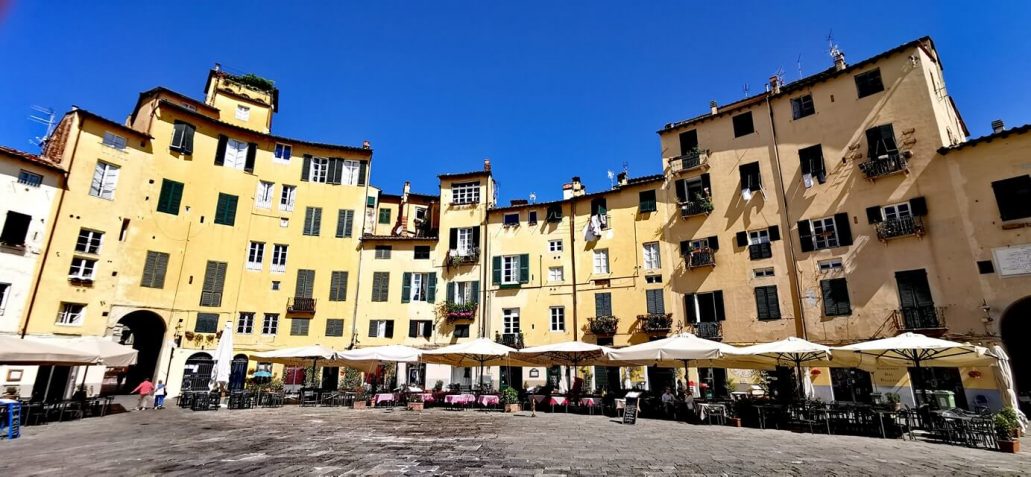
Piazza dell’Anfiteatro (square of the amphitheater) is the heart of Lucca and one of its symbols. Derived from an imposing amphitheater built by the Romans, the square retains its closed elliptical shape and has always been a meeting place and point of reference for the city and political life. The architect Lorenzo Nottolini, who in the nineteenth century dismantled some of the buildings built inside the amphitheater and built this urban masterpiece, is the author of the current beauty of Piazza dell’Anfiteatro. The harmony of this square is grasped by admiring it from the center and is largely due to the absence of large openings. Access to the square, in fact, takes place through four small doors, so this gives it the appearance of a “closed square.” Characteristic restaurants and shops overlook the square, especially in summer, events, shows, and concerts.
Lucca Cathedral

Another special place in Lucca is the Cathedral of San Martino, founded in the sixth century. This imposing Romanesque religious building has an asymmetrical facade. A curious and singular peculiarity, especially if you think about how rigid the canons were at the time, but the facade had to adapt to the already existing bell tower (it is worth climbing the 60 meters of the bell tower from which you can enjoy a wonderful view on Lucca). Inside the three-nave Cathedral are works of art of great interest, such as the statue of San Martino in the act of sharing his cloak with a poor man, Tintoretto’s Last Supper, and Ilaria del Carretto’s Funeral Monument, by Jacopo della Quercia. But the work to which the people of Lucca are most fond of is the ancient crucifix of the Holy Face (or Holy Cross), which would represent the true face of Christ. Also not to be missed is the nearby Museum of the Cathedral: eight rooms among which the hall of choirs and illuminated manuscripts and that of the Treasury with the Jewels of the Holy Face stand out. A few meters from the Cathedral, there is also the Monumental and Archaeological Complex of San Giovanni and Santa Reparata. The monumental portal remains of the church from 1100, while the interior tells of the city’s evolution over the centuries. The walkways that allow you to “walk” on the remains of the original church from 1100 are fascinating.
San Michele Church
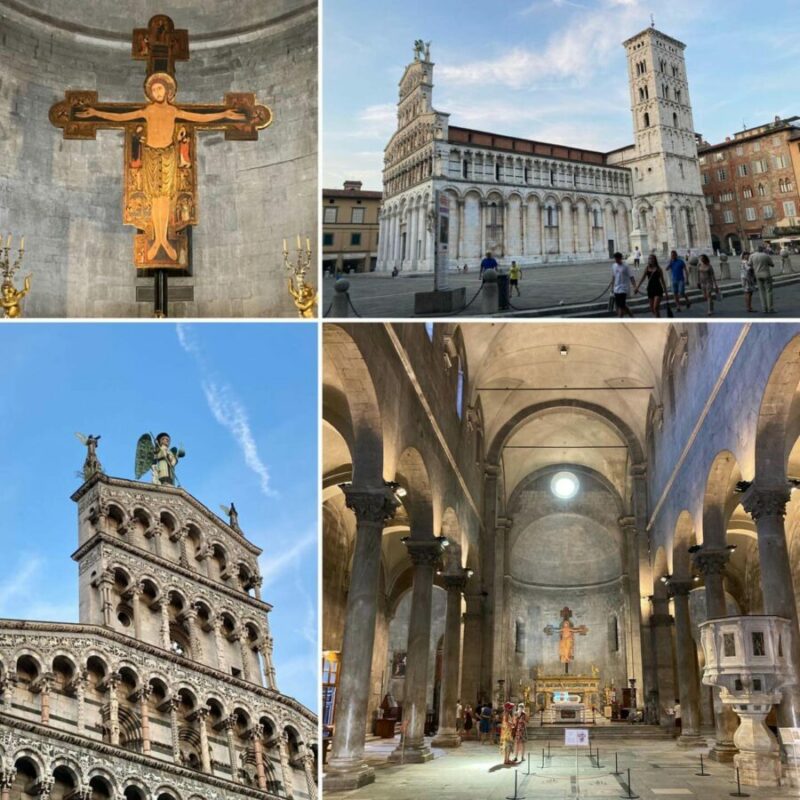
Another important place of worship to visit in Lucca is the Church of San Michele, located in the square of the same name. Pope Alexander II commissioned the church at the beginning of the year 1000. It has an imposing and majestic facade and, since its construction was very long, today it is a splendid superimposition of styles, from Romanesque to Gothic. It is striking for the very high facade that rises four meters above the roof and stands the statue of St. Michael the Archangel in the act of killing the Dragon.
Basilica of San Frediano
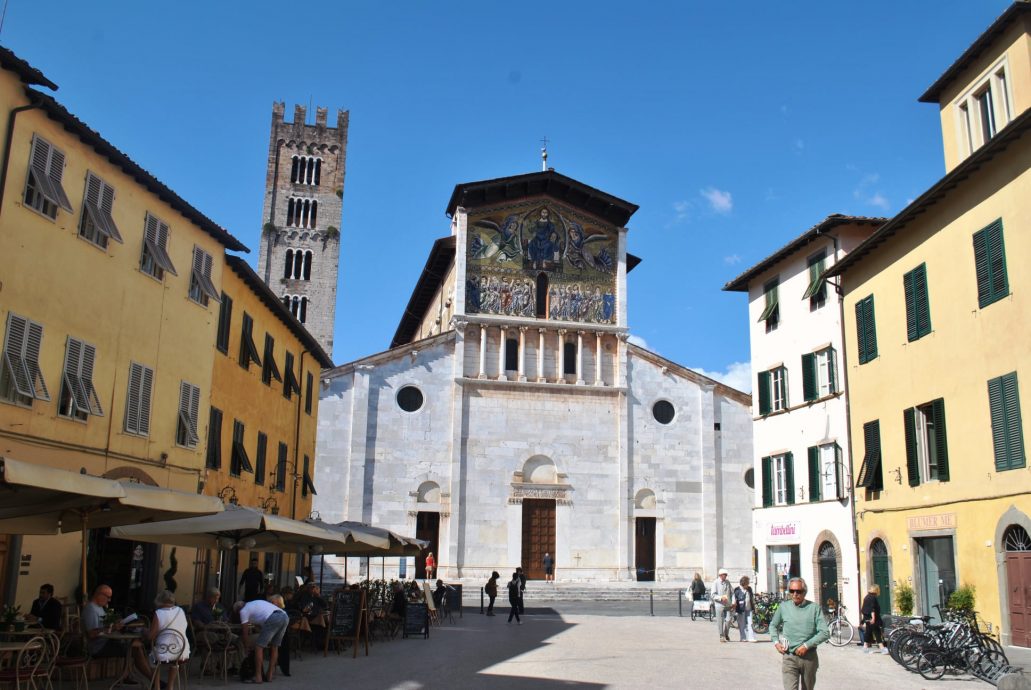
The church of San Frediano, dating back to the 5th century AD, is also one of the most important churches in Lucca. This medieval church is famous for the mosaic on the facade depicting the ascent of Christ into heaven. Equally worthy of attention is the baptismal font located to the right of the entrance, embellished with beautiful reliefs depicting sacred scenes. Entrance to the church is subject to a fee.
Piazza Napoleone, Lucca
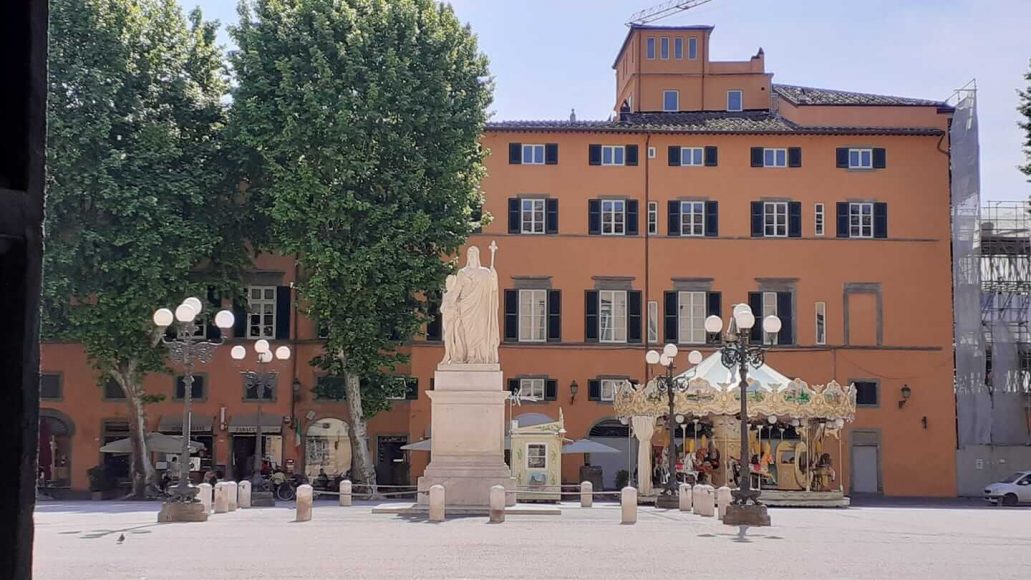
Another important square in Lucca is Piazza Napoleone, the largest one in the city. Today, you can admire the Ducal Palace and the headquarters of the Lucca Art Institute, heir to the Lucca Academy of Fine Arts. Today the Ducal Palace houses the offices of the Province of Lucca, and the square is a space with shops, bars, and restaurants, a meeting place for people from Lucca and tourists. The Ducal Palace has a significant history. The Duchess Elisa Baciocchi first inhabited the Palace and later was the seat of the government until the annexation to the Grand Duchy of Tuscany in 1847. The Ducal Palace owes its present appearance to the artist Bartolomeo Ammannati and his late sixteenth-century works.
Mansi Palace

In Via Galli Tassi 43, you can admire the splendor of Mansi Palace and its art gallery. The most important collection of paintings in Lucca is housed in this beautiful 17th-century building that belonged to the rich Mansi family. Here original furnishings of the seventeenth century and works by artists such as Tintoretto and Luca Giordano, Pontormo, and Bronzino show off. In the first room, the large paintings are collected. The second room is called ‘dei Medici’ because it almost exclusively houses portraits of the Tuscan family. In the third room are collected the small-format paintings that deal mainly with religious themes. Finally, in the fourth and last room, there are some Flemish and French paintings.
Massoni Palace

Massoni Palace, in via dell’Angelo Custode 24, is also worth a visit. The garden inside, of seventeenth-century origin, is an indescribable spectacle of floral and architectural decorations.
Renaissance walls of Lucca

We have said that the Renaissance walls of Lucca are probably among the first images that come to mind when we think of this city. They are the only example of defensive walls of the modern age that have survived intact to this day and are the only ones that can be completely covered both on foot and by car (although today it is forbidden to drive by car). Built between the sixteenth and seventeenth centuries, these walls extend for four and a half kilometers (and 30 meters wide), with their eleven bastions, three gates, and the spectacular urban park where you can take a panoramic walk in the shade of centuries-old trees that let you glimpse, here and there, playgrounds for children and recreational areas equipped for relaxing picnics. The place is an unmissable destination for tourists and one of the most loved places by the citizens of Lucca.
Tower Delle Ore

In the Middle Ages, there were 250 towers in Lucca. Today only two towers remain the Guinigi Tower and the “Delle Ore” Tower. The “Delle Ore” Tower (tower of the hours) was built in 1390 and is the highest tower in Lucca. The top can only be reached after climbing the 207 steps of the original wooden staircase, still in excellent condition. The current clock was made in 1754 thanks to the collaboration of the Lucca watchmakers, and its manual mechanism is still one of the most important working examples in the world today.
Guinigi Tower
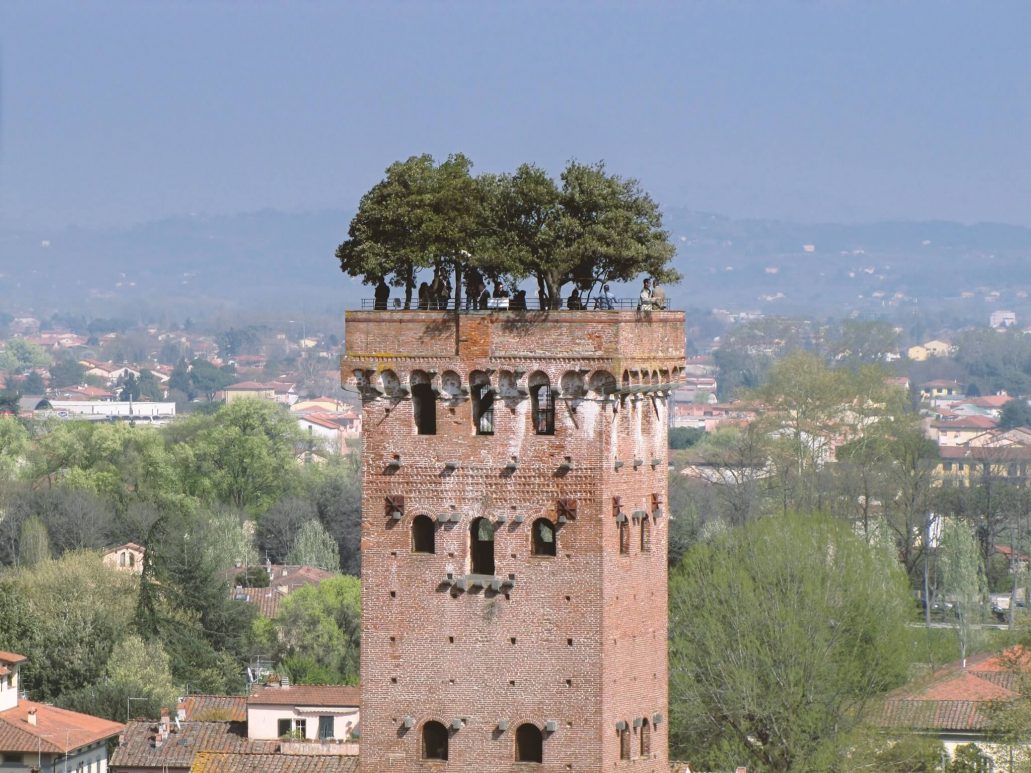
Another tower worth seeing is the Guinigi Tower. Of all the towers that belonged to private families in Lucca, this is the only one that has not been destroyed. For this reason, it is still possible to appreciate the unique spectacle of its 45 meters high and the splendid hanging garden on its top, a spectacular feature that distinguishes it.
The Botanical Garden of Lucca

For lovers of nature and plants, there is the opportunity to visit the Botanical Garden, near the historic center of Lucca, an important and splendid garden that extends over two hectares, commissioned in 1820 by the Duchess Maria Luisa of Bourbon. The Botanical Garden is a vibrant nursery with hundreds of species inside.
Puccini’s Birth Home

Lucca then pays homage to one of its most illustrious citizens – Giacomo Puccini – with a museum dedicated to him. In fact, in the historic center, there is the apartment where Puccini was born on December 22, 1858, and transformed into a museum in 1979. The years of his youth and the first approaches to music are witnessed, in this almost magical place, by the objects that belonged to the famous composer: scores, instruments, letters, stage costumes—a journey through time to meet a great artist.
Via Fillungo, Lucca

Those who love shopping cannot fail to take the most famous street in Lucca, where all the most important and well-known shops are located: via Fillungo. During the walk through the streets of Lucca, a stop, even a short one, could be the ideal opportunity to enter one of the many shops and taste one of the most characteristic local products of the city: the famous “Buccellato,” made of bread with raisins.
Antico Caffè de Le Mura

After exploring Lucca, it is a must to rest and enjoy the pleasures of Italian cuisine, perhaps near the city walls. The Antico Caffè de Le Mura is very elegant in its nineteenth-century setting and the central area; this cafè was designed by Carlo Ludovico di Borbone, who transformed the small military barracks into one of the most visited places in Lucca today. Also, thanks to a cuisine linked to the Lucca tradition made of meat dishes, typical soups of the Garfagnana, and a particular focus on fish from Viareggio. From its beautiful terrace, you can admire the whole of Lucca.
Popular Traditional Foods in Lucca
The cuisine of Lucca fits, for ingredients and flavors, into the rich Tuscan tradition: poor, genuine, and almost always with local products. A return to tradition for those visiting Lucca. The soups stand out among the first courses, such as spelled, made with beans, spices, and ham; the “garmugia,” with onions, peas, artichokes, asparagus, fresh broad beans, meat, bacon, oil, and toasted bread croutons. Always among the first courses are the farinata, the “tordelli” (fresh pasta), the “matuffi” (soft polenta), and the vegetable flans. The second courses include stewed rabbit, roasted cod with chickpeas, and, above all, the “rovelline”: slices of beef in breadcrumbs and fried sautéed in a sauce with tomatoes and capers. They usually are eaten with mashed potatoes. The desserts are also closely linked to the territory: in addition to the “buccellato,” among other desserts, we mention the “castagnaccio” (chestnut flour, with shelled walnuts, pine nuts, orange peel, raisins, rosemary, oil) and the “necci” (chestnut flour and ricotta crepes). Finally, we have the chocolate cake with a filling of boiled rice, dark chocolate, cocoa, candied fruit, pine nuts, raisins, nutmeg, eggs.
Palazzo Pfanner
For those who still have time available, just outside the walls of Lucca, there is an extraordinary 17th-century palace with a wonderful Italian Baroque garden: Palazzo Pfanner. Built-in 1660 by a wealthy local family who commissioned the architect Martinelli to design the building and Filippo Juvarra from Messina the garden. Over the centuries, it changed ownership until it became, in 1846, owned by the Pfanner family, brewers, who built the first brewery in the Duchy of Lucca in this building and one of the first in Italy: the Pfanner brewery.
Festival & Events in Lucca
Lucca is also home to numerous events every year, attracting visitors from all over the world. One of these is the “Summer Festival” (with musical concerts by internationally renowned artists in various places in the city), which is usually held during July, while at the end of October-early November, the “Lucca Comics & Games. ” This is the most important international comics festival in Italy during which fairs and market exhibitions of the most varied types of comics are set up, and not only: the whole city becomes a sort of cartoon, where more or less famous characters come to life by the hand of fans who dress up with assiduous fidelity or bizarre fantasy, giving life to a unique show of its kind.
Think your friends would be interested? Share “things to do in Lucca”!







